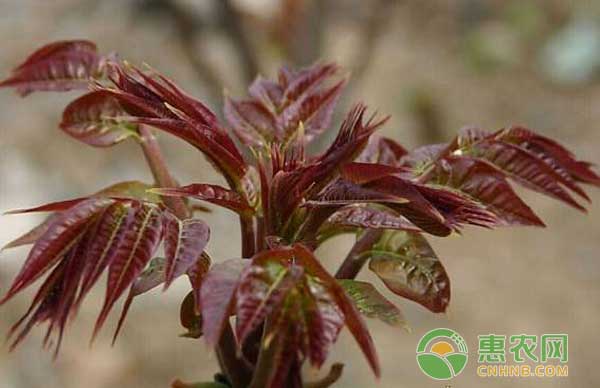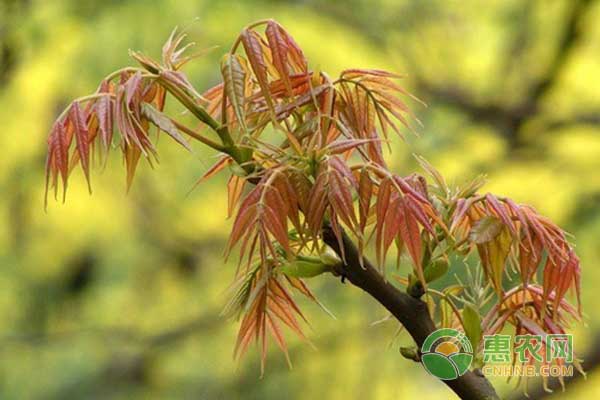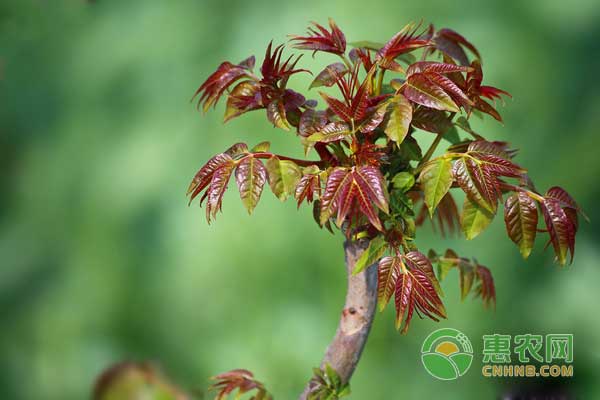During the Han Dynasty, the toon and the lychee were two famous tributes. The citron sprouts before the Qingming, and it is harvested before and after the rain. The first picking of the head buds is tender and delicious, and the flavor is rich. It has a unique flavor and flavor with the eggs, because it has been loved by people since ancient times.
At present, the toon on the market costs more than 20 yuan a small amount, which is already very high in vegetables. However, the citron is a seasonal vegetable, only the spring has a fragrant scent, and only spring to eat is delicious. Here is a look at the cultivation and preservation techniques of camphor.

1, nursery
The seedlings of Toona sinensis can be used in both asexual reproduction and sexual reproduction. Asexual reproduction is the seedlings and shoot cuttings commonly used by the masses. It is simple and easy to manage. The disadvantage is that it is difficult to provide seedlings quickly and in large quantities. The large-scale anti-season production of axillary buds in the solar greenhouse requires large seedlings and concentration. Generally, seed propagation or cultivation is carried out or tissue culture technology is used for rapid propagation. However, the latter has not been put into practical use in actual production, so seeding is carried out for sexual reproduction. The method of seedlings is the main route in current production.
Seed nursery:
1 Seed selection and treatment: Choose as much as possible of fresh seeds with similar climate and other growing conditions. The germination rate should be determined according to the prescribed method before sowing.
2 soaking seeds and germination: Toona sinensis seeds must be soaked and germinated before sowing. The method can be different depending on the conditions of production. It is more difficult to achieve constant temperature germination after soaking. If the conditions are poor, the following method can be used: put the warm water (30-40 ° C) which is about 3 times the volume of the seed in the container, pour the seeds into the container and stir constantly. When the water temperature drops to 25 ° C, replace it with new warm water. Wash, wash and then warmed for 12 hours with warm water, then remove the seeds and drain the water, mix well with 2-3 volumes of wet sand, put it into the warm simmer or germination in the greenhouse, then adjust the temperature in time (about 25 ° C) And humidity (the humidity of the sand is held in groups by hand but not dripping). After about 1 week, 30% of the seeds can be sown when exposed.
3 suitable sowing: the fragrant scent is warmer to the low temperature, the germination temperature is about 8-12 ° C, 14 ° C can grow normally. The suitable sowing date for spring sorghum is generally from the end of March to the beginning of April. If the filming period after the sowing is covered, it can be appropriate early. Choose fertile, loose, well-lit plots to make nursery grounds. Pour the bottom water before sowing. When the soil is dry, it will be flattened in time. The trenches are opened at a line spacing of 25×30 cm. The width of the furrow is 5-6 cm. After the ditch is spread, cover 1 cm thick tidal soil. The seeding density is 3-4 kg per mu, and the seedlings are about 15,000 mu.
4 seedling management: After 7 days of seeding without seeding, the seeds began to be unearthed. It takes about half a month to get out of the seedlings. Such as covering the mulch film can accelerate the emergence of seedlings, but need to pay attention to prevent high temperature damage. When the seedlings begin to arch the soil, it is necessary to break the membrane and release the seedlings in time and press the membranes tightly. The roots of the seedlings are underdeveloped and the seeding is shallow, so they are most afraid of water shortage and cold. When there are 3 true leaves, they should be watered once. It is best to spray 15-20 °C warm water. After 5 cm of seedling height, the amount of water should be appropriately reduced. Pay attention to cultivating loose soil and alfalfa. The seedlings were carried out when 4-5 leaves were used. Strengthen the management of water and fertilizer after the seedlings to cultivate strong seedlings. From June to August, the rapid growth period of seedlings is also a key period for cultivating strong seedlings. During this period, phosphorus, potassium and calcium fertilizers should be combined with irrigation, and plant growth regulators should be sprayed to promote the lignification of seedlings. Cold ability to form a full top bud. In order to cultivate strong seedlings to prevent the seedlings in the rainy season, the seedlings were dwarfed after June, laying a good foundation for the greenhouse production after the autumn. It is currently considered that the best effect is the treatment of camphor seedlings with paclobutrazol. Methods The perennial seedlings began at the end of June. In the middle of July, the seedlings began to use 15% paclobutrazol 200-400 times liquid in the middle and late July, and sprayed 2-3 times every 10-15 days to control the length and early. Capping and dwarfing increase dry matter accumulation.

2, transplanting
(1) Planting and seedling transplanting: For the development of the courtyard economy and the ecological construction of the cultivated land, the transplanting of large seedlings can be appropriately adopted. The strong seedlings with a diameter of 1 cm or more and a plant height of 1 m or more are transplanted before the spring leaves are germinated. The tree pit is dug as much as possible, with a diameter of 1 m and a depth of 0.8-1 m. The fertilizer is applied and the water is poured in time. The saplings transplanted in autumn are filled with winter water before freezing, and the saplings are properly protected against freezing.
(2) transplanting seedlings for greenhouses: seedlings for winter warm greenhouses, generally after the late autumn leaves (before the beginning of the first half of October), the average daily temperature is 3-5 °C. First, we will carry out land preparation, fertilization, and hoeing, planting in large and small rows, and rationalizing the root system. For example, in the north-south direction, the seedlings should be in the south and the seedlings in the north. The planting plant spacing is generally 15-20 cm, the kneading surface is 1 m wide, and each row is planted 3 rows, with a density of 8,000-10,000 plants per mu.
3. Production management technology
(1) Dew-scented scented scented scallions for vegetables, weeding and loosening soil every year, especially the eucalyptus planted in the arable land, combined with sloping soil to apply organic fertilizer and appropriate amount of nitrogen fertilizer, using single planting (1—2×0.2-0.5 m) ) or cultivating (2 × 0.5-1 m, 3-5 per hole), the plant type is cultured according to actual conditions, and the commonly used plant types are multi-layer type, broom type, short jungle type, shrub type, etc. Branches and growth increase the yield of sprouts. For the buds and the citron, the density can be determined according to the actual conditions, and the buds are not harvested within 2-3 years after planting. When the tree is more than 3 meters high, the top is picked up and the side branches are promoted.
(2) greenhouse fragrant
Temperature control: The quality of axillary buds produced by temperature control at 18-25 °C is best. When the local temperature reaches 18 °C in late spring or early summer, the film should be removed in time to allow the seedlings to receive natural sunlight.
Temperature control: water management should be moderate, pay attention to too wet and easy to rotten seedlings, dry and poor development, the ground humidity is hand-kneaded into a group, let go of the granules.
Fertilization management: In addition to sufficient nitrogen and phosphorus fertilizers, the base fertilizer has higher requirements for potassium fertilizer. For each 200 square meter greenhouse, 2 kg of potassium dihydrogen phosphate or 50 kg of grass ash should be added.
Top branching: The seedlings moved into the greenhouse after the autumn leaves are not topping, so that they can produce head buds, and can carry out photosynthesis to promote root growth during growth, and topping rods when picking buds. It can be cut at 40 cm on the ground, and the paclobutrazol is sprayed once after the rod to promote dwarfing and branching. After each picking axillary buds, it must be topped according to the development of the tree shape to ensure more branches and more buds.
Pest control: greenhouse scent is generally pest-free. In order to produce high-quality green products, it is strictly forbidden to apply residual fertilizers and pesticides. Air disinfection can be carried out by artificial high-voltage discharge lightning technology, once every 10 days, in one greenhouse at the same time in three places, both insecticidal sterilization and increase production. The main diseases in Daejeon production are: root rot, leaf rust, dry blight, powdery mildew. Insect pests include brown-spotted green moth, and white-spotted beetle. The roots of the roots can be sprayed with the roots of the zinc, the Bordeaux mixture, the dexamethasone, and the like. Use stone sulfur mixture and powder rust to control leaf rust. Dry blight is controlled with thiophanate and zinc chloride glycerol or 10% alkaline water. Control powdery mildew with stone sulfur mixture and Bordeaux mixture, detoxification powder and rusting. Pests can be trapped by lights or bait.
Bagging and promoting technology: After removing the greenhouse, the camphor receives natural sunlight growth, which is fast and easy to fibrillate, affecting its quality. In order to improve the product quality and ensure the crispy characteristics of the axillary bud, when the axillary bud grows to about 5 cm, it can be covered with a black and red 2 layer polyethylene film bag to grow light. When it is 15 cm long, the bag is taken off and removed. The bag is used repeatedly. Some also directly put on the soil egg shell, it is said that the fragrant scent that grows in the egg shell has a faint egg fragrance, which is more popular by the market.

4, the preservation method of camphor
The picking period of the camphor is short and fresh and perishable. When placed at room temperature for 2-3 days, the freshness, flavor or texture will be greatly reduced. Almost lost the unique food value in less than a week. Therefore, it is imperative to develop an effective preservation method.
(1) Short-term preservation method.
1 Soaking method: bundled into 0.5 kg, the base of the bundle should be flush, vertically immersed in a clean solution containing 3-4 cm of deep water for 24 hours, and then placed in a cool and ventilated room to keep fresh 6- 8 days.
2 bags of low temperature method: put the camphor buds into a clean food bag according to a 0.25-0.5 kg and tie the bag mouth, the household is stored in a small amount, can be placed in the home refrigerator 0-1 ° C environment, a large number of storage can be placed In the constant temperature library at 0-1 °C, this preservation method can be used for 15-20 days.
(2) Long-term preservation method.
1 preservative method: commonly used preservatives are 6-benzyl hydrazine BA, thiophanate, carbendazim, allicin and so on. Spray the preservative evenly on the camphor before storage, then put it into a food bag with a width of 50 cm and a length of 40 cm, and fasten it in a cold storage at 0-1 °C, and open the bag for 1 time every 10-15 days. Keep fresh for about 2 months.
2 Silicone method: The sealed crate of the citron is placed in a nylon sandbag coated with a silicone mixture and sealed in a sealed state, and stored in a cold storage at 0-1 ° C for about 60 days.
3 gas adjustment method: At present, the atmosphere storage is considered to be a storage technology with rapid development, long storage period and best preservation effect. The method is to put the camphor bud into a plastic big account, and introduce a mixed gas into the account, so that the amount of O2 contained in the account is kept 2-3%, CO25-6%, and stored in a constant temperature library of 0-1 ° C to keep fresh 3 About a month.
(3) The problem that should be paid attention to when keeping fresh. No matter what method is used to preserve the citron in the preservation, do not pile up together to prevent heat and decay. The camphor is easy to fall in the environment above 10 °C, easy to change color below -2 °C, the humidity is too low and easy to wilting, so the suitable storage temperature is 0-1 °C, and the suitable relative humidity is 90-95%.
The above is the cultivation and preservation technology of camphor, I hope to help you. If you want to know more about agricultural technology, please pay attention to the Hui Nong School!
Fiberglass Grating
The fiberglass grating also named FRP grating & fiberglass grid, and the fiberglass grating panels can be made into FRP grating cover, fiberglass walkway grating, fiberglass trench grating and so on.
The fiberglass grating is light in weight and has good elasticity, so it can be cut freely during the installation process, without using lifting equipment, and only a small amount of labor and cutting tools are required. Because the FRP grid is made of non-metallic materials, the corrosion resistance of the FRP grid is very good. The FRP grid will not rust and rust under the chemical medium, nor will it damage the structure of the material.
Beyond that, the color of fiberglass grating including yellow, gray, green and as your demands.

Fiberglass Grating,Fiberglass Dock Grating,Fiberglass Trench Grating,Frp Ceiling Grid Mesh
ANPING COUNTY SHANGCHEN WIREMESH PRODUCTS CO.,LTD , https://www.scwiremesh.com